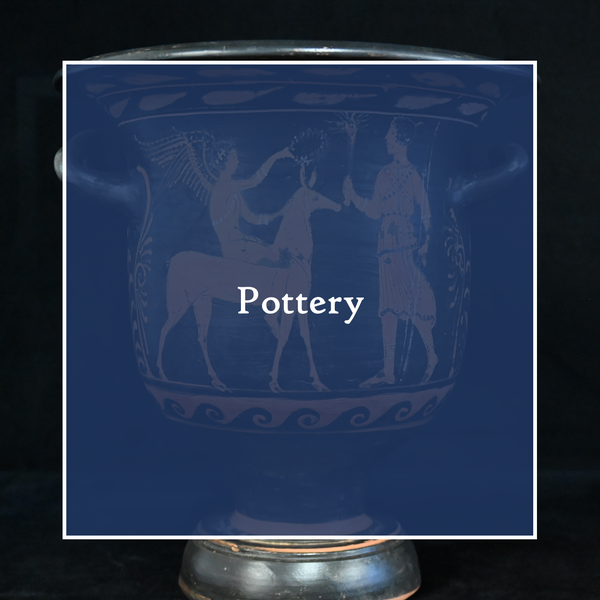Pottery
|
Pottery are an important type of find for archaeology. Since they have a relatively short period of use, but offer a variety of functions and uses, they were mass produced in antiquity. At the same time, preferences with regard to the shape and types of vessels changed frequently, so that the different forms can be very easily classified chronologically. The figuratively decorated vessels also provide information about the norms and values of ancient societies.
Black-figure style The black-figure technique was developed in Corinth around 700 BC. From 630 BC it was adopted by Attic potters and perfected in Athens. In this technique, figures and ornaments are applied to the vessel with particularly fine, diluted clay slip. Details on the faces, bodies or garments of the figures are incised before kilning. Red-figure style Around 530 BC, the red-figure technique was developed in Athens. Figures and ornaments are left out in this technique, while the entire background is painted with clay slip. Details such as garment folds are indicated by fine lines applied with a hair brush. After kilning, the clay-ground figures stand out against the black background. The red-figure and black-figure techniques coexisted for a time until the red-figure technique largely prevailed around the turn of the 6th to 5th century BC. |
|
|
White-ground technique The white-ground technique was developed in 530/20 BC and used in parallel with black- and red-figure vase painting. The vases receive their characteristic white coating through the use of a clay slip containing kaolinite. The figures were painted on in outline. Non-mineral colours such as red or blue were used for details such as clothing. Since the surface of the vessels was relatively sensitive and the colours did not last well, white-ground painted vases were not suitable for everyday use. Such vessels were mainly used as votive offerings and in funerary contexts. The pictures show scenes from the living environment of women as well as scenes at the grave. From 430 BC onwards, the technique is only found on lekyths and finally ends around 400 BC.
|
Black-glazed ware In the course of the 4th century BC, the production of figuratively decorated pottery came to an end in most production sites. Instead, a new form of pottery came into fashion, the body of which was completely covered with black varnish. Decorative elements are now limited mainly to painted ornaments such as vines and other floral elements in red or white. Particularly high-quality examples of such black-glazed pottery are found in the "Gnathia pottery", named after its first place of discovery, Egnazia, in Apulia. More rarely, figures are also depicted on the vessels. |
|
Relief pottery At the end of the 3rd century BC, around 240 BC, a new manufacturing technique emerged that made it possible to produce vessels in series and therefore spread rapidly throughout the Mediterranean region. This pottery, the so-called relief pottery, was no longer produced on the potter's wheel, but was made from a prefabricated mould. The first step was to make a negative mould: this was made on the potter's wheel, and decorations were pressed into the inside of the bowl with the help of stamps or punches. This bowl was then kilned. In a second step, clay was pressed into this mould. On the finished vessel, the decorations finally appear as embossed relief decoration. Since the mould was reusable, this technique made it quick and easy to mass-produce uniform vessels. Famous Hellenistic examples of this type are the so-called "Megaric cups", hemispherical drinking vessels with brown to black coating and mostly floral relief decoration, which are named after one of the places where they were found, the city of Megara, near Athens. Other production centres were located in eastern Greece, the Black Sea region and Asia Minor.
|
Terra Sigillata In Roman times, the technique of producing vessels with the help of moulds was finally perfected and Roman terra sigillata became the export hit of the ancient world. The vessels were dipped into a liquid, ferruginous clay slip when leather-hard and then kilned at over 900 degrees Celsius. Other decoration techniques include the application of relief appliqués or the so-called barbotine technique, in which decorations are applied to the surface of the vessel with a thick clay slip, as well as incised decorations. Roman terra sigillata production began around 40 BC in Arretium, today's Arrezzo, modelled on Hellenistic relief pottery. In the 2nd century AD, the type then spread throughout the Mediterranean region and was also produced in North Africa. In today's Germany, large production centres are known, for example, in Trier (Augusta Treverorum) and Rheinzabern (the ancient Tabernae). |

